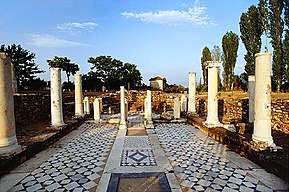Heraclea Lyncestis
| Ἡράκλεια Λυγκηστίς / Ἡράκλεια Λύγκου | |

The Byzantine "small basilica" at Heraclea Lyncestis
|
|
| Alternate name | Herakleia Lynkestis |
|---|---|
| Location | Bitola, Pelagonia Statistical Region, Macedonia |
| Region | Lynkestis |
| Coordinates | 41°00′39″N 21°20′33″E / 41.01083°N 21.34250°ECoordinates: 41°00′39″N 21°20′33″E / 41.01083°N 21.34250°E |
| Type | Settlement |
| History | |
| Builder | Philip II of Macedon |
| Founded | Middle of the 4th century BC |
| Periods | Hellenistic to Byzantine |
Heraclea Lyncestis also spelled Herakleia Lynkestis (Greek: Ἡράκλεια Λυγκηστίς; Latin: Heraclea Lyncestis; Macedonian: Хераклеа Линкестис, was an ancient Greek city in Macedon, ruled later by the Romans. Its ruins are situated 2 km south of the present-day town of Bitola, Macedonia. It was founded by Philip II of Macedon in the middle of the 4th century BC. The city was named in honor of the mythological Greek hero Heracles. The name Lynkestis originates from the name of the ancient kingdom, conquered by Philip, where the city was built.
Heraclea was a strategically important town during the Hellenistic period, as it was at the edge of Macedon's border with Epirus to the west and Paeonia to the north, until the middle of the 2nd century BC, when the Romans conquered Macedon and destroyed its political power. The Romans divided Macedonia into 4 regions and Heraclea was in the fourth region. The main Roman road in the area, Via Egnatia went through Heraclea, and Heraclea was an important stop. The prosperity of the city was maintained mainly due to this road. Objects discovered from the time of Roman rule in Heraclea are votive monuments, a portico, thermae (baths), a theatre and town walls.
In the early Christian period, Heraclea was an important Episcopal seat. Some of its bishops are mentioned in synods in Serdica and other nearby towns. The city was gradually abandoned in the 6th century AD following an earthquake and Slavic invasions.
...
Wikipedia

